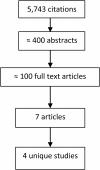Interventions to encourage discussion of end-of-life preferences between members of the general population and the people closest to them - a systematic literature review
- PMID: 24188214
- PMCID: PMC3826509
- DOI: 10.1186/1472-684X-12-40
Interventions to encourage discussion of end-of-life preferences between members of the general population and the people closest to them - a systematic literature review
Abstract
Background: Discussing end of life preferences can be beneficial, and it is thought that the best time to have these conversations is usually when people are well. This review aims to establish current evidence for the effectiveness of community-based interventions to encourage people to consider, and to discuss with those closest to them, their preferences for end of life care or what they wish to happen after their death.
Methods: A systematic literature review was undertaken. A systematic search was conducted using Scopus and Google, and academic experts were contacted. Studies were included if they evaluated interventions intended to encourage people to discuss their end of life preferences with those closest to them, or to address known barriers to these discussions. Reported outcomes had to relate to attitude or behaviour change in the target group, or target group perceptions of the intervention. Studies were excluded if the intervention targeted only people with a life-limiting illness, or intended specifically to facilitate communication of end of life preferences between patients and healthcare staff. Studies were systematically described and assessed for quality. There was no attempt to combine results of different studies.
Results: The Scopus search identified 5,743 citations, and the Google search identified over 40,000, of which the first 40 pages were scanned. Five studies were included, four identified through the Scopus search and one from a book identified through Google. Three studies reported positive results, two were less positive. A peer education programme on end of life planning for older people, featuring small discussion workshops, was positively appraised by participants. An arts project bringing hospice users and school pupils together appeared to help normalise death for school pupils. A public information 'roadshow' engaged people using an informal questionnaire survey, facilitating conversations between people who participated together. Public lectures by physicians intending to promoting home death as a possibility were unsuccessful in changing attitudes at six months follow-up. A module on end of life planning delivered as part of 'expert patient' education programme on the management of chronic illness was not well received by participants.
Conclusions: Available evidence highlights the importance of actively engaging people rather than passively providing information, and of ensuring an appropriate context for interventions. However, data are limited and there is a need for more research and for sharing of best practice.
Figures
Similar articles
-
Promoting and supporting self-management for adults living in the community with physical chronic illness: A systematic review of the effectiveness and meaningfulness of the patient-practitioner encounter.JBI Libr Syst Rev. 2009;7(13):492-582. doi: 10.11124/01938924-200907130-00001. JBI Libr Syst Rev. 2009. PMID: 27819974
-
The future of Cochrane Neonatal.Early Hum Dev. 2020 Nov;150:105191. doi: 10.1016/j.earlhumdev.2020.105191. Epub 2020 Sep 12. Early Hum Dev. 2020. PMID: 33036834
-
Behavioural modification interventions for medically unexplained symptoms in primary care: systematic reviews and economic evaluation.Health Technol Assess. 2020 Sep;24(46):1-490. doi: 10.3310/hta24460. Health Technol Assess. 2020. PMID: 32975190 Free PMC article.
-
Beyond the black stump: rapid reviews of health research issues affecting regional, rural and remote Australia.Med J Aust. 2020 Dec;213 Suppl 11:S3-S32.e1. doi: 10.5694/mja2.50881. Med J Aust. 2020. PMID: 33314144
-
Advance care planning for adults with heart failure.Cochrane Database Syst Rev. 2020 Feb 27;2(2):CD013022. doi: 10.1002/14651858.CD013022.pub2. Cochrane Database Syst Rev. 2020. PMID: 32104908 Free PMC article.
Cited by
-
Knowledge Gaps in End-of-Life Care and Planning Options Among Older Adults in Switzerland.Int J Public Health. 2022 Aug 25;67:1604676. doi: 10.3389/ijph.2022.1604676. eCollection 2022. Int J Public Health. 2022. PMID: 36090825 Free PMC article.
-
Information meetings on end-of-life care for older people by the general practitioner to stimulate advance care planning: a pre-post evaluation study.BMC Fam Pract. 2021 Jun 7;22(1):109. doi: 10.1186/s12875-021-01463-3. BMC Fam Pract. 2021. PMID: 34092218 Free PMC article.
-
Development and Validation of the Readiness for End-of-Life Conversations (REOLC) Scale.Front Psychol. 2021 Mar 19;12:662654. doi: 10.3389/fpsyg.2021.662654. eCollection 2021. Front Psychol. 2021. PMID: 33868137 Free PMC article.
-
Discussing end of life wishes - the impact of community interventions?BMC Palliat Care. 2019 Mar 7;18(1):26. doi: 10.1186/s12904-019-0407-8. BMC Palliat Care. 2019. PMID: 30845931 Free PMC article.
-
Understanding public attitudes to death talk and advance care planning in Northern Ireland using health behaviour change theory: a qualitative study.BMC Public Health. 2022 May 6;22(1):906. doi: 10.1186/s12889-022-13319-1. BMC Public Health. 2022. PMID: 35524295 Free PMC article.
References
-
- Office for National Statistics. Statistical Bulletin: Births and Deaths in England and Wales, 2011 (Final) 2012. http://www.ons.gov.uk.
-
- National End of Life Care Intelligence Network. National End of Life Care Profiles for Primary Care Trusts. NHS National End of Life Care Programme ed; 2012. http://www.end of life care-intelligence.org.uk.
-
- Hickman SE, Tilden VP, Tolle SW. Family perceptions of worry, symptoms, and suffering in the dying. J Palliat Care. 2004;20:20–27. - PubMed
LinkOut - more resources
Full Text Sources
Other Literature Sources


